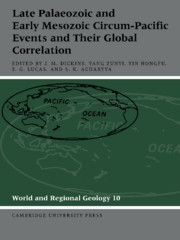Book contents
- Frontmatter
- Contents
- List of contributors
- Preface
- 1 Major global change: framework for the modern world
- 2 Carboniferous-to-Triassic evolution of the Panthalassan margin in southern South America
- 3 Permian and Triassic geologic events in Sonora, northwestern Mexico
- 4 Advances in the correlation of the Permian
- 5 Examples of late Hercynian transtensional tectonics in the Southern Alps (Italy)
- 6 Succession of selected bioevents in the continental Permian of the Southern Alps (Italy): improvements in intrabasinal and interregional correlations
- 7 Permian chronostratigraphic subdivisions and events in China
- 8 Indosinian Tectogeny in the geological correlation of Vietnam and adjacent regions
- 9 Sitsa flora from the Permian of South Primorye
- 10 Late Permian bimodal volcanism in South Primorye
- 11 Syngenetic and epigenetic mineral deposits in Permian and Triassic sequences of the Primorye region
- 12 The mid-Permian: major changes in geology, environment, and faunas and some evolutionary implications
- 13 Variations in the disappearance patterns of rugosan corals in Tethys and their implications for environments at the end of the Permian
- 14 Fluctuations in pelagic environments near the Permian–Triassic boundary in the Mino-Tamba Terrane, southwest Japan
- 15 Late Changxingian ammonoids, bivalves, and brachiopods in South Primorye
- 16 Radiolaria from Permian–Triassic boundary beds in cherty deposits of Primorye (Sikhote-Alin)
- 17 Early Mesozoic magmatism in the Russian Far East
- 18 Transgressive conodont faunas of the early Triassic: an opportunity for correlation in the Tethys and the circum-Pacific
- 19 Triassic biostratigraphy and palaeobiogeography of East Asia
- 20 Classification and correlation of Triassic limestones in Sikhote-Alin on the basis of corals
- 21 Evolution of the platform elements of the conodont genus Metapolygnathus and their distribution in the Upper Triassic of Sikhote-Alin
- 22 Late Triassic North American halobiid bivalves: diversity trends and circum-Pacific correlations
- 23 Upper Triassic Chinle Group, Western United States: a nonmarine standard for late Triassic time
- 24 Otapirian Stage: its fauna and microflora
- 25 Upper Palaeozoic glaciation and Carboniferous and Permian faunal changes in Argentina
- Index
3 - Permian and Triassic geologic events in Sonora, northwestern Mexico
Published online by Cambridge University Press: 13 October 2009
- Frontmatter
- Contents
- List of contributors
- Preface
- 1 Major global change: framework for the modern world
- 2 Carboniferous-to-Triassic evolution of the Panthalassan margin in southern South America
- 3 Permian and Triassic geologic events in Sonora, northwestern Mexico
- 4 Advances in the correlation of the Permian
- 5 Examples of late Hercynian transtensional tectonics in the Southern Alps (Italy)
- 6 Succession of selected bioevents in the continental Permian of the Southern Alps (Italy): improvements in intrabasinal and interregional correlations
- 7 Permian chronostratigraphic subdivisions and events in China
- 8 Indosinian Tectogeny in the geological correlation of Vietnam and adjacent regions
- 9 Sitsa flora from the Permian of South Primorye
- 10 Late Permian bimodal volcanism in South Primorye
- 11 Syngenetic and epigenetic mineral deposits in Permian and Triassic sequences of the Primorye region
- 12 The mid-Permian: major changes in geology, environment, and faunas and some evolutionary implications
- 13 Variations in the disappearance patterns of rugosan corals in Tethys and their implications for environments at the end of the Permian
- 14 Fluctuations in pelagic environments near the Permian–Triassic boundary in the Mino-Tamba Terrane, southwest Japan
- 15 Late Changxingian ammonoids, bivalves, and brachiopods in South Primorye
- 16 Radiolaria from Permian–Triassic boundary beds in cherty deposits of Primorye (Sikhote-Alin)
- 17 Early Mesozoic magmatism in the Russian Far East
- 18 Transgressive conodont faunas of the early Triassic: an opportunity for correlation in the Tethys and the circum-Pacific
- 19 Triassic biostratigraphy and palaeobiogeography of East Asia
- 20 Classification and correlation of Triassic limestones in Sikhote-Alin on the basis of corals
- 21 Evolution of the platform elements of the conodont genus Metapolygnathus and their distribution in the Upper Triassic of Sikhote-Alin
- 22 Late Triassic North American halobiid bivalves: diversity trends and circum-Pacific correlations
- 23 Upper Triassic Chinle Group, Western United States: a nonmarine standard for late Triassic time
- 24 Otapirian Stage: its fauna and microflora
- 25 Upper Palaeozoic glaciation and Carboniferous and Permian faunal changes in Argentina
- Index
Summary
The Palaeozoic and Mesozoic strata of northwestern Mexico are exposed in small, scattered areas in Sonora and Baja California because of the Tertiary tectonic events in normal faulting, the pervasive effects of Tertiary intrusives, and the widespread volcanic cover of the Sierra Madre Occidental (Figure 3.1). However, the early investigations, followed by more recent geologic work in that region, allow us to unravel the late Palaeozoic and early Mesozoic sedimentologic and tectonic history of that part of Mexico.
In this chapter we examine the sedimentologic and tectonic history of the Permian and Triassic geologic events in northwestern Mexico, with special reference to the state of Sonora. The younger Palaeozoic rocks of Sonora are of early and middle Permian age. These rocks are parts of thicker Palaeozoic successions that are of cratonic-platform character in the northeastern part of the state, of shallow-water miogeoclinal character in the northwestern and central parts of Sonora, and of deep-water eugeoclinal character in the central part of the state (Figure 3.2). Permian rocks of eugeoclinal character have been reported from one locality in Baja California. The Triassic rocks of Sonora, which are of Carnian and Norian age, can be grouped into two lithotectonic assemblages. In the central part of the state, these rocks are recognized as part of the Barranca Group (Alencaster, 1961a), whereas in northwestern Sonora they are included in the Antimonio Formation (González-León, 1980).
- Type
- Chapter
- Information
- Publisher: Cambridge University PressPrint publication year: 1997



